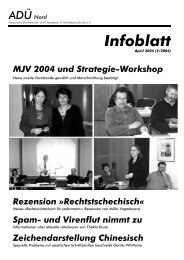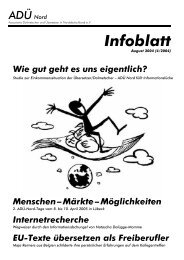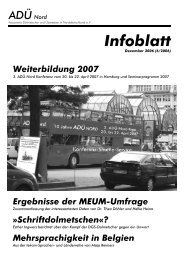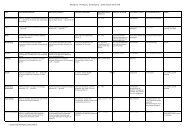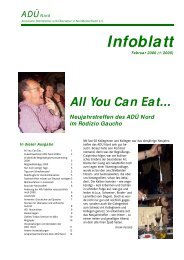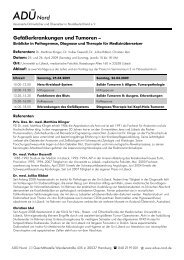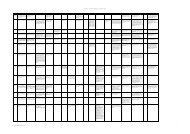Infoblatt - ADÜ Nord
Infoblatt - ADÜ Nord
Infoblatt - ADÜ Nord
Erfolgreiche ePaper selbst erstellen
Machen Sie aus Ihren PDF Publikationen ein blätterbares Flipbook mit unserer einzigartigen Google optimierten e-Paper Software.
Seite 9 · 5/1999 · <strong>ADÜ</strong> <strong>Nord</strong> <strong>Infoblatt</strong><br />
The four categories rejected “because of time constraints”<br />
were “participial constructions, adjuncts,<br />
nominalizations, and idiomatic expressions.”<br />
But how valid are their testing procedures, and how<br />
likely are their findings to reach their goal? As the<br />
editors of the second volume confess in their final<br />
summary, “testing the linguistic coverage of an MT<br />
system is a tedious, time-consuming task.” And a note<br />
of unintended comic relief is provided by the one<br />
MT developer invited to take part, when he points out<br />
first of all that:<br />
Methods for evaluating machine translations and machine<br />
translation systems have been proposed, discussed,<br />
and applied for more than 40 years now, including<br />
numerous attempts at defining objectively<br />
measurable criteria to capture aspects of translation<br />
quality. Nevertheless, a worryingly large number of<br />
evaluation reports have more or less explicit disclaimers<br />
as to the absolute value of the results, or confess to<br />
flaws in the procedure.<br />
and then draws the precise conclusion one might expect<br />
from an MT developer:<br />
The obvious solution to these problems is of course to<br />
avoid translation quality as a direct object for evaluations<br />
and to stay with a general impression of the role<br />
which quality plays for the overall acceptability of a MT<br />
system.<br />
And there are other moments of unintended comic<br />
relief. For instance, the abstract for one paper tells us<br />
that the reason for these labor-intensive researches is<br />
because “these systems require small-scale evaluation<br />
methods which can be carried out without the<br />
developers’ cooperation.” And we learn that the advent<br />
of the latest and cheapest systems has spurred<br />
even the mighty Association for Machine Translation<br />
in the Americas to discuss a so-called “MT Seal of<br />
Approval” at their 1998 conference.<br />
And amid all the precious examples of MT output, a<br />
few more fully certified gems emerge:<br />
“It is a pity that I can’t speak French” becomes in German<br />
“Es ist französisch ein Mitleid, das ich nicht kann<br />
sprechen.”<br />
While “The dog that had eaten the hamburger ran<br />
away” is truly turned into hamburger: „Der Hamburger<br />
lief der Hund, der gefressen hatte, davon.”<br />
It is a relief to report after all these testing procedures,<br />
graphs, tables, and countless examples, that<br />
the editors do finally reach a conclusion about the six<br />
principal systems that have been evaluated. Based on<br />
their experiments, they determine that<br />
Logos, Personal Translator Plus 98 (Linguatec/IBM),<br />
and in many cases Systran belong to the top three. T1<br />
Professional (Langenscheidt) is in the middle field,<br />
sometimes also Systran, and Transcend (Intergraph)<br />
and Power Translator Pro (Globalink) always come last.<br />
The first volume is almost entirely in English, while the<br />
second volume weaves quite seamlessly between<br />
German and English. In so doing the editors inadvertently<br />
show something of their own basic linguistic<br />
orientation by inventing two new English abbreviations<br />
(or at least new to this reviewer) on the basis of<br />
familiar German ones. Thus, in Volume 1 we find<br />
“resp.,” no doubt a German stab at “respectively,”<br />
presumably on the basis of German “bzw.”, while<br />
Volume 2 yields “a.o.,” evidently an attempt to duplicate<br />
the German “u.a.,” for “among others.” Both of<br />
these are certainly good tries and perhaps ought to<br />
exist in English, but they do raise certain doubts as to<br />
the overall English capabilities of the authors, especially<br />
when they confess that “advanced students of<br />
English (all native German speakers)” performed all<br />
the English post-editing in one task supposedly<br />
evaluating how long this should take.<br />
This linguistic orientation is perhaps also revealed in<br />
the paper I find most interesting, the first volume’s final<br />
offering: The Automatic Translation of Idioms:<br />
Machine Translation vs. Translation Memory Systems<br />
by Martin Volk. This piece comes down firmly on the<br />
side of Translation Memory as being superior to MT<br />
for translating idioms. But I question its basic dichotomy,<br />
that there is a clear and discernible difference<br />
between what we call “idioms” on the one hand and<br />
the “more predictable” parts of language on the<br />
other. I am not altogether sure that this dichotomy<br />
will stand up to any truly close analysis, particularly if<br />
we begin to consider more exotic languages, which<br />
even MT developers claim they will one day be able<br />
to include by using an “Interlingual” approach.<br />
It might be supposed that this is merely a linguistic<br />
quibble, and that surely what appear to be simple<br />
sentences of the type “You are beautiful” must be<br />
much the same the world around. But I can easily<br />
conceive of languages and cultures—and I believe<br />
many of our readers can as well—where the words<br />
“You,” “are,” and even “beautiful” might be up for<br />
grabs and pose unexpected problems even for human<br />
translators—and certainly for machine translation<br />
systems as well. It could yet turn out that all—or<br />
almost all—of language is unpredictably and close<br />
to arbitrarily idiomatic in nature. And that only the<br />
coincidence of two languages, such as English and<br />
German or English and French, growing closely together<br />
over several centuries, has persuaded us that<br />
this may not be the case.<br />
The reviewer is grateful to Bob Bononno, Vigdis Eriksen,<br />
and Helmut Leuffen for help and advice in preparing this<br />
review.<br />
(© Copyright 1998 Translation Journal and the Author)




